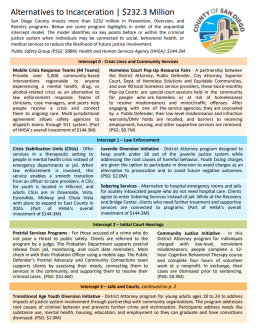Goals of the Alternatives to Incarceration Project
Goals
- Prioritize alternatives to incarceration as a public safety, equity, and health strategy, and evaluate rehabilitative services in these domains.
- Prevent justice system involvement by identifying and addressing individual and community needs and addressing justice system disparities and disproportionalities, including referrals, access to and use of supportive services and custody alternatives.
- Prevent people in behavioral health crisis from entering jail by providing behavioral health-focused alternative responses and settings.
- Identify booking alternatives for low-level misdemeanor drug and public conduct charges.
- Expand community-based rehabilitative options that support pretrial releases and provide sentencing options to reduce incarceration and time in jail for those who do not pose a public safety threat.
- Promote success in the community after release from custody through transitional planning in-custody and connections to community-based supportive services.
- Provide
evidence-based, person-centered services that reduce recidivism,
assist with basic and immediate needs, and increase individual-level
health, self-sufficiency, and positive personal relationships and
community connections.
Guiding Principles
- Actions aim to increase equitable access to care and supportive services, provide culturally sensitive service delivery, and prevent systemic disproportionalities.
- Cross-agency collaboration and input from broad stakeholders and community members, including people with lived experience and their families, are essential.
- Supportive public services should be easy to access and located in areas with the greatest need, and effective services should be regionalized.
- A broad spectrum of coordinated services should be available to meet the basic, complex, intersectional needs of justice-involved individuals.
- Data collection and sharing among justice, health and community partners are key to meeting the complex needs of justice-involved individuals, evaluating programs, and system planning.




